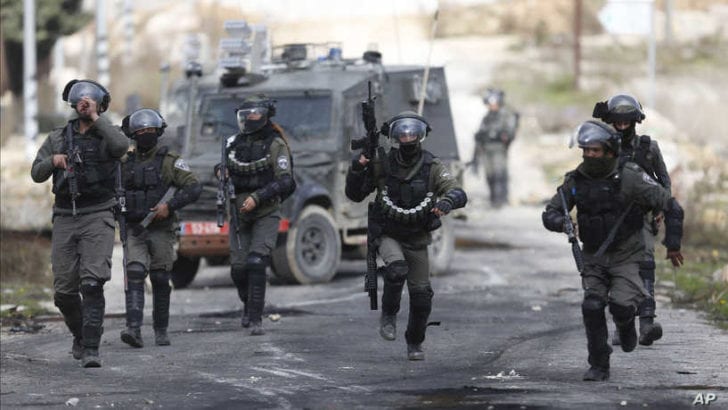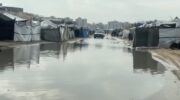Israeli border police take position during clashes with Palestinian demonstrators as they protest Middle East peace plan announced Tuesday, near the West Bank city of Ramallah, Feb 1, 2020.
United Nations Office for the Coordination of Humanitarian Affairs (UNOCHA)
Protection of Civilians Report | 21 January – 3 February 2020


Read full, detailed report here.
Latest development (initial reports)
- On 5 February, Israeli forces shot and killed a 17-year-old Palestinian boy during clashes in Hebron city.
- On 6 February, Israeli forces shot and killed two Palestinian men during clashes in Jenin city, which erupted during a punitive demolition; one of the fatalities was a Palestinian policeman who was reportedly present inside a police station at the time of the clashes.
- On 6 February, a Palestinian man opened fire at Israeli forces in the Old City of Jerusalem and was subsequently shot and killed; one Israeli policeman was injured.
- On 6 February, a Palestinian run with a truck into a group of Israeli soldiers in West Jerusalem, injuring 13 of them, before escaping the scene unharmed.
Biweekly highlights
- On 21 January, Israeli forces shot and killed three Palestinians, including two youths (18-years-old) and a 17-year-old child, after they crossed through the perimeter fence from Gaza into Israel and reportedly threw an explosive device at the soldiers. No Israeli injuries were reported. Their bodies have been withheld by the Israeli authorities.
- A 14-year-old Palestinian boy, who was hit in the head by a tear gas canister fired by Israeli forces during a ‘Great March of Return’ (GMR) demonstration on 10 November 2019, died of his wounds. His death, on 31 January, brings to 214 the total number of fatalities in the GMR demonstrations since they began on 30 March 2018, including 47 children. By end 2019, the organizing committee of the GMR announced that the weekly demonstrations would stop until 30 March 2020, and then continue on a monthly and ad-hoc basis. Since 28 January, a number of protests against the US plan for the Middle East were held near the perimeter fence with Israel, during which 11 Palestinians, including three children, were injured by Israeli forces.
- Palestinians from Gaza (including armed groups) launched multiple rockets and mortars, as well as bundles of balloons tied to explosive devices towards Israel. The projectiles were either intercepted in the air or landed in open areas. An Israeli woman and her baby were injured while running to a shelter in Sderot city.
- The Israel army carried out a series of airstrikes targeting armed groups’ facilities in Gaza, two of which resulted in the injury of two Palestinian children. Additionally, on 2 January, the Israeli authorities suspended the entry of cement into Gaza and revoked the exit permit of 500 business people. These attacks and measures were reportedly carried out in response to the launching of rockets and explosive balloons from Gaza.
- On at least 30 occasions, Israeli forces opened warning fire in the areas adjacent to Israel’s perimeter fence and off the coast of Gaza; three injuries including a child were reported. In a separate incident, Israeli naval forces arrested three Palestinian fishermen, including a child, and confiscated their boat.
- In the West Bank (as of the end of the reporting period), 287 Palestinians, including 43 children and eight women were injured in clashes ongoing since 28 January in connection to the release of the US plan for the Middle East. The largest clashes were recorded in Beita village (Nablus), Bethlehem city, the Beit-El/DCO checkpoint (Ramallah), Hebron city, Al ‘Eizariya town (Jerusalem), Khirbet ‘Atuf village and Tayasir checkpoint (the latter two in Tubas). Over 80 per cent of the injuries were treated for tear gas inhalation, 16 per cent were hit by rubber bullets and 2 per cent by live ammunition. During clashes in Hebron city, the uniforms of an Israeli soldier and a Border Police officer were caught on fire after Palestinians threw Molotov-cocktails at them.
- Another 49 Palestinians were injured by Israeli forces in other clashes recorded earlier during the reporting period, including eight children. Twenty-five injuries were recorded in the Beit Hanina area of East Jerusalem, during clashes that erupted following rumours that a missing Palestinian boy had been kidnapped by Israeli settlers; the boy was later found dead, reportedly after he drowned in a water cistern. Another 13 Palestinians were injured during ad-hoc clashes in Al ‘Eizariya town (Jerusalem), and five were injured during the weekly protests in Kafr Qaddum village (Qalqiliya). Of concern, an 11-year-old Palestinian boy was hit in the head with a tear gas canister shot by Israeli forces during clashes near Burin school (Nablus), triggering the suspension of classes for the rest of the day. These incidents bring the total number of injuries during the reporting period to 336, more than double the bi-weekly average of injuries in 2019 (136 injuries).
- Israeli forces carried out 81 search and arrest operations across the West Bank, and arrested 89 Palestinians, including 12 children. The majority of the operations were in the Hebron Governorate (23), followed by Jerusalem (19) and Ramallah (14) governorates. The situation in Al Isawiya neighbourhood of East Jerusalem has remained tense, as regular police operations continued: following one of the operations, a 14-year-old Palestinian girl lost consciousness and was evacuated to a hospital, reportedly due to trauma she suffered after her home was searched by police forces.
- Citing the lack of building permits, the Israeli authorities demolished, or forced Palestinians to demolish, ten structures in Area C and East Jerusalem, displacing nine people and affecting 41 others. Five of the targeted structures, including one previously provided as humanitarian aid, were located in Area C, in Az Zawiya village (Salfit) and in Al Khalayleh, a small community in the Jerusalem area separated from the rest of the West Bank by the Barrier. The remaining five structures were in East Jerusalem, including one in a community (Khirbet Khamis) severed from the city by the Barrier. Three of the structures in East Jerusalem were demolished by their owners following the receipt of demolition orders.
- Individuals believed to be Israeli settlers set on fire a school and a mosque, vandalized 189 Palestinian-owned trees and injured four Palestinians. The arson incidents took place on 28 and 24 January in a school in Einabus village (Nablus) and a mosque in the Sharafat area of East Jerusalem, respectively. In both incidents graffiti in Hebrew were sprayed on the buildings’ walls. In two separate incidents near Bruchin and Shave Shomron settlements, settlers cut down 182 trees belonging to farmers from Kafr ad Dik (Salfit) and Sebastiya (Nablus) villages. Nearby, Israeli settlers raided Madama village (Nablus), where they stoned Palestinian houses, vandalized olive-trees and injured two Palestinians in subsequent clashes. Another two Palestinians farmers from As Sawiya village (Nablus) were stoned and injured by a group of Israeli settlers while working their land. One Palestinian vehicle sustained damage in a separate incident of stone-throwing near Haris village (Salfit).
- An Israeli girl was injured near the Gush Etzion settlement area (Bethlehem) and at least seven Israeli-plated vehicles were damaged, following stone and Molotov cocktail throwing by Palestinians at travelling cars along West Bank roads, according to various Israeli sources.






